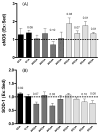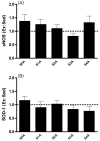Vascular nitric oxide: effects of exercise training in animals
- PMID: 18347669
- PMCID: PMC2646586
- DOI: 10.1139/H07-146
Vascular nitric oxide: effects of exercise training in animals
Abstract
Exercise training is known to induce several adaptations in the cardiovascular system, one of which is increased skeletal muscle blood flow at maximal exercise. Improved muscle blood flow, in turn, could in part be accounted for by augmented endothelium-dependent, nitric oxide (NO)-mediated vasodilation. Studies have indeed demonstrated that endothelium-dependent, NO-mediated dilation of conductance-type vessels is augmented after endurance exercise training; recently, this adaptation has been extended into resistance-type vessels within rodent skeletal muscle. With the latter, however, it appears that only resistance vessels supplying muscle active during training sessions exhibit this adaptation. These findings in rats are in contrast to those from human studies, in which increased endothelium-dependent dilation has been observed in vasculatures not associated with elevated blood flow during exercise. Increased expression of endothelial NO synthase (eNOS) appears to underlie enhanced endothelium-dependent, NO-mediated dilation of both conductance and resistance vessels. Greater eNOS expression may also underlie the preventive and (or) rehabilitative effect(s) of exercise training on atherosclerosis, given that NO inhibits several steps of the atherosclerotic disease process. Thus, exercise training may induce adaptations that benefit both vasodilation and vascular health.
Figures





Similar articles
-
Vascular nitric oxide: effects of physical activity, importance for health.Essays Biochem. 2006;42:119-31. doi: 10.1042/bse0420119. Essays Biochem. 2006. PMID: 17144884 Review.
-
Effects of different levels of exercise volume on endothelium-dependent vasodilation: roles of nitric oxide synthase and heme oxygenase.Hypertens Res. 2008 Apr;31(4):805-16. doi: 10.1291/hypres.31.805. Hypertens Res. 2008. PMID: 18633193
-
Effects of exercise training on endothelium-dependent peripheral vascular responsiveness.Med Sci Sports Exerc. 1995 Aug;27(8):1152-7. Med Sci Sports Exerc. 1995. PMID: 7476059 Review.
-
Nonuniform effects of endurance exercise training on vasodilation in rat skeletal muscle.J Appl Physiol (1985). 2005 Feb;98(2):753-61. doi: 10.1152/japplphysiol.01263.2003. Epub 2004 Sep 24. J Appl Physiol (1985). 2005. PMID: 15448126
-
Endothelium-mediated control of coronary vascular tone after chronic exercise training.Med Sci Sports Exerc. 1995 Aug;27(8):1135-44. Med Sci Sports Exerc. 1995. PMID: 7476057 Review.
Cited by
-
Daily physical activity enhances reactivity to insulin in skeletal muscle arterioles of hyperphagic Otsuka Long-Evans Tokushima Fatty rats.J Appl Physiol (1985). 2010 Oct;109(4):1203-10. doi: 10.1152/japplphysiol.00064.2010. Epub 2010 Jul 15. J Appl Physiol (1985). 2010. PMID: 20634354 Free PMC article.
-
Effects of moderate and high intensity isocaloric aerobic training upon microvascular reactivity and myocardial oxidative stress in rats.PLoS One. 2020 Feb 7;15(2):e0218228. doi: 10.1371/journal.pone.0218228. eCollection 2020. PLoS One. 2020. PMID: 32032358 Free PMC article.
-
Physical activity-induced remodeling of vasculature in skeletal muscle: role in treatment of type 2 diabetes.J Appl Physiol (1985). 2016 Jan 1;120(1):1-16. doi: 10.1152/japplphysiol.00789.2015. Epub 2015 Oct 15. J Appl Physiol (1985). 2016. PMID: 26472876 Free PMC article. Review.
-
Canonical and extra-telomeric functions of telomerase: Implications for healthy ageing conferred by endurance training.Aging Cell. 2023 Jun;22(6):e13836. doi: 10.1111/acel.13836. Epub 2023 Apr 11. Aging Cell. 2023. PMID: 37041671 Free PMC article. Review.
-
Exercise, vascular stiffness, and tissue transglutaminase.J Am Heart Assoc. 2014 Apr 10;3(2):e000599. doi: 10.1161/JAHA.113.000599. J Am Heart Assoc. 2014. PMID: 24721796 Free PMC article.
References
-
- Berliner JA, Navab M, Fogelman AM, Frank JS, Demer LL, Edwards PA, Watson AD, Lusis AJ. Atherosclerosis: basic mechanisms. Oxidation, inflammation, and genetics. Circulation. 1995;91:2488–2496. - PubMed
-
- Delp MD, McAllister RM, Laughlin MH. Exercise training alters endothelium-dependent vasoreactivity of rat abdominal aorta. J Appl Physiol. 1993;75:1354–1363. - PubMed
-
- Indolfi C, Torella D, Coppola C, Curcio A, Rodriguez F, Bilancio A, et al. Physical training increases eNOS vascular expression and activity and reduces restenosis after balloon angioplasty or arterial stenting in rats. Circ Res. 2002;91:1190–1197. doi: 10.1161/01.RES.0000046233.94299.D6. - DOI - PubMed
-
- Laughlin MH, Armstrong RB. Muscular blood flow distribution patterns as a function of running speed in rats. Am J Physiol. 1982;243:H296–H306. - PubMed
Publication types
MeSH terms
Substances
Grants and funding
LinkOut - more resources
Full Text Sources

